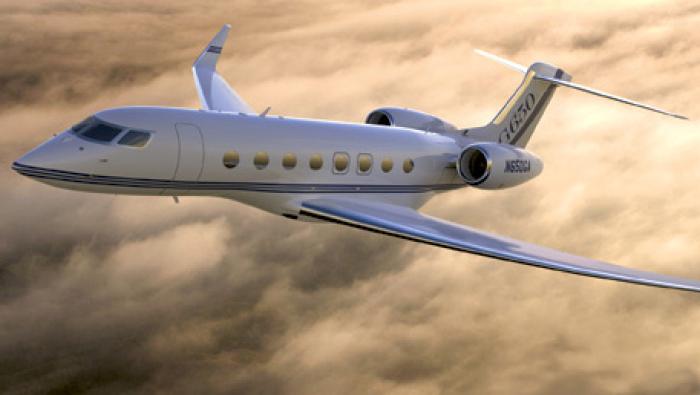Dassault’s new Falcon 7X, which is making its public debut this week in Paris, will fly in this morning’s aerial display scheduled during the official visit of French President Jacques Chirac. The rest of the week the three-engine business jet will grace Dassault’s static display, but won’t fly again until Saturday for the general public and the airshow visit by French prime minister Dominique de Villepin. The French manufacturer of business and military aircraft reports orders for more than 55 of the $37 million 7X. The next available delivery position is in 2009.
Dassault Aviation chief flight test pilot Yves “Bill” Kerherve and chief pilot for civil flight test Philippe Deleume will fly the new jet’s left and right seats, respectively, during the displays, which will attempt to show “the aircraft flying well,” in Kerherve’s words. However, compared with the airshow display of a fighter–like the Dassault Rafale for which Kerherve led the flight testing–the flight characteristics that distinguish the 7X, the world’s first fly-by-wire business jet, are more difficult to appreciate from the ground than from the cockpit.
Deleume said the 7X very nearly flies itself, since the flight-control computers automatically trim the aircraft to the position selected by the pilot. “The workload for the pilot is very low,” said Deleume, who explained that the pilot essentially needs only set the throttles and the position of the side-stick control to the attitude desired and the computers do the rest.
Pilot workload is further reduced by the airplane’s EASy flight deck, designed in conjunction with Honeywell and developed for the Falcon 900EX and Falcon 2000EX. The system displays information on four 14.1-inch, flat-panel screens and allows pilots to enter data using cursor control devices and menu-driven selections while keeping their heads up, instead of looking down at console-mounted equipment.
Still, you may be able to discern some of this during Kerherve’s and Deleume’s flight display. Among other maneuvers, after takeoff and raising the landing gear, they plan to make a 60-degree banked circle at about 225 knots and 1,000 feet. They’ll follow this with a low-speed pass, gear down, at about 110 knots, then retract the gear again, make a go-around and come back for a high-speed pass at about 250 knots.
15-month Flight Test Program
The 7X here in Paris is the first and so far only flying example of the model. It has logged some 45 flight hours on 15 flights, since its first flight on May 5. Flight testing resumed just last week, after the aircraft was grounded to calibrate test equipment. The second aircraft will join the flight test program next month and the third in September, the first time Dassault will be using three airplanes in a certification program. By the end of the year, the company plans to fit the third airplane with its interior, to test its comfort, air-conditioning system and noise level, which Dassault hopes will be no higher than 52 dB, or about as quiet as the quietest 900EX. (The company is showing a mockup of a 7X interior at its static display.) The third airplane will also be used for long-range and endurance testing. The flight-test program is expected to take 15 months and about 1,200 flight hours, culminating in EASA and FAA certification.
Falcon test pilots have flown the 7X up to 45,000 feet, as fast as Mach 0.80 and as slow as 100 knots (more than 20 degrees angle of attack), just above its stall speed. They have also taken the airplane to 3g.
Dassault produces business jets with both two and three engines, but its trijets are a recognized trademark not shared with any other business jet manufacturer. So one may wonder why Dassault chose three engines for the 7X, when conventional wisdom might suggest that two could be sufficient and probably less costly. Addressing this question, Olivier Villa, senior vice president of civil aircraft, said there were three reasons for the company’s decision.
“First, three engines have lower drag than two engines with the equivalent thrust, especially with the third engine mounted about the fuselage,” he claimed. The second reason was based on customer concern about safety, particularly on long overwater flights. “This is not to say that twin-engine jets are not safe crossing the Atlantic, but many customers have told us they prefer the redundancy of a third engine.” Finally, for the aircraft size and performance that Dassault wanted for the 7X, there were simply no engines available with the thrust needed for a twin configuration.
Dassault therefore chose the three-engine configuration and selected the Pratt & Whitney Canada PW307A turbofan, flat rated to 6,100 pounds thrust for takeoff at 18.4 degrees C at sea level.
Performance specifications for the 7X (with eight passengers, three crew, NBAA IFR reserves and ISA conditions) include a balanced field length of 5,200 feet at 63,600 pounds; an approach speed of 104 knots and landing distance of 2,350 feet, at 37,100 pounds; and a range of 5,700 nm at Mach 0.8. Mission capability east- and southbound from Paris includes nonstop flights to Tokyo, Beijing and Johannesburg. Westbound from Paris, the 7X will reach New York, Mexico City and São Paulo. Maximum operating Mach is expected to be at least 0.90. Maximum altitude will be 51,000 feet.
The business jet’s interior dimensions include a maximum cabin height of 6 feet 2 inches, a cabin length of 39 feet 1 inch (from the baggage door to and including the third flight deck seat) and baggage volume of 140 cubic feet. Maximum takeoff weight is 63,700 pounds, maximum landing weight is 60,500 pounds, basic operating weight is 33,100 pounds and usable fuel capacity is 28,900 pounds.
Dassault is quietly making plans to use the 7X wing on future developments dubbed 5X (possibly a twin-engine version of the 7X) and 9X (which could be an ultra-long-range bizjet).







